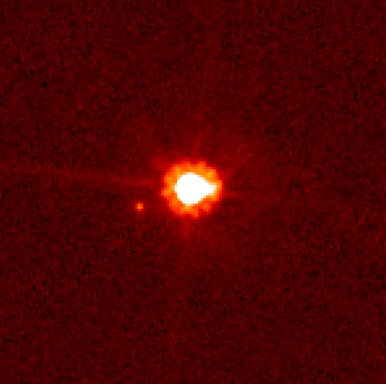Sam's Solar System is a combination geocaching and second grade science fair project. It's a model of the solar system built to a scale of 1/71,504,324. While that seems like a big number, it means that an astronomical unit (the average distance between the sun and Earth) is 1.3 miles in the model.
Our model sun is located in the new Preston Ballfields park. If you drive to the park, you'll see a cul-de-sac with a big circular planted area in the center. The circle is 62 feet in diameter, and we used it to set the scale of the model. To get the full educational benefit of the series, you really should stop by and look at the sun so you have a good feel for it. Plus, it's very close to the parking area for getting Venus, so you might as well.
There is a geocache for each of the eight planets and the three dwarf planets, plus a bonus cache for anyone who puts in the travel to get the first eleven. Inside each of the planetary caches is a scale model of the planet represented by the cache (on the same scale as the distances between the planets). They range in size from about a half inch in diameter for Ceres (the smallest dwarf planet) to 6 feet, four inches for Jupiter. You should look at each of the planets to get a feel for how big they are, both relative to each other, to the sun, and especially to the interplanetary distance between them.
On the inside cover of the log books in each of the caches is a six digit number. You need to collect all eleven of these numbers to get the coordinates of the bonus cache. There are instructions on the bonus cache page explaining what to do with them. For now, it’s just important to write down the number.
Caches in the series:
Sam's Solar System: Mercury
Sam's Solar System: Venus
Sam's Solar System: Earth
Sam's Solar System: Mars
Sam's Solar System: Ceres
Sam's Solar System: Jupiter
Sam's Solar System: Saturn
Sam's Solar System: Uranus
Sam's Solar System: Neptune
Sam's Solar System: Pluto
Sam's Solar System: Eris
Sam's Solar System: Bonus
Facts about Eris:
Maximum distance from the sun: 14,600,000,000 km (97.6 AU)
Minimum distance from the sun: 5,6500,000,000 km (37.8 AU)
Length of year: 203,600 days (557 Earth years)
Radius of dwarf planet: 1300 km (.20 Earths) Mass of planet: 8.7 x 10^25 kg (.0028 Earths)
Moons: Dysnomia
Eris was discovered on January 5, 2005 based on an analysis on images taken on October 21, 2003. Eventually, it was determined that Eris' mass is about 27% greater than Pluto's by examining the way Dysnomia orbits it.
Eris' discovery forced astronomers to decide on a precise definition for "planet." The International Astronomical Union adopted a definition on August 24, 2006 that excluded Eris and Pluto. They also introduced a new category, "dwarf planet," which included Eris, Pluto and also Ceres, which had previously been considered to be the largest of the asteroids.
We decided to include the dwarf planets in Sam's Solar System, and so you get an opportunity to visit Lewis County (as well as nearly getting into Skagit County while finding Pluto).
Eris has a very eccentric (non-circular) orbit. Because of this, we could have put it nearly 50 miles farther from the sun than we did. For example Hood River, OR would have been near its farthest point.
In our scale, Eris is about 2/3 of an inch in diameter (check out the version taped to the inside lid of the lock-n-lock). Imagine trying to see something that small in Hood River from Preston, WA, and you can see why it took until 2005 to find.
